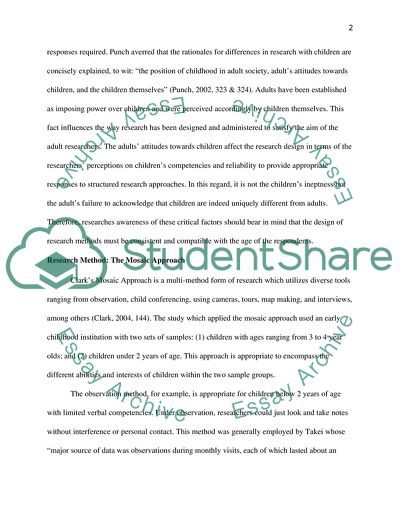Cite this document
(The Mosaic Approach and Research with Young Children Case Study, n.d.)
The Mosaic Approach and Research with Young Children Case Study. Retrieved from https://studentshare.org/social-science/1737988-how-does-the-age-of-research-participants-impact-upon-the-choice-of-data-collection-tools-in-a-research-project-illustrate-your-answer-with-examples-from-the-course-materials-and-an-appropriate-article-of-your-choice-from-the-journal-childhood
The Mosaic Approach and Research with Young Children Case Study. Retrieved from https://studentshare.org/social-science/1737988-how-does-the-age-of-research-participants-impact-upon-the-choice-of-data-collection-tools-in-a-research-project-illustrate-your-answer-with-examples-from-the-course-materials-and-an-appropriate-article-of-your-choice-from-the-journal-childhood
(The Mosaic Approach and Research With Young Children Case Study)
The Mosaic Approach and Research With Young Children Case Study. https://studentshare.org/social-science/1737988-how-does-the-age-of-research-participants-impact-upon-the-choice-of-data-collection-tools-in-a-research-project-illustrate-your-answer-with-examples-from-the-course-materials-and-an-appropriate-article-of-your-choice-from-the-journal-childhood.
The Mosaic Approach and Research With Young Children Case Study. https://studentshare.org/social-science/1737988-how-does-the-age-of-research-participants-impact-upon-the-choice-of-data-collection-tools-in-a-research-project-illustrate-your-answer-with-examples-from-the-course-materials-and-an-appropriate-article-of-your-choice-from-the-journal-childhood.
“The Mosaic Approach and Research With Young Children Case Study”. https://studentshare.org/social-science/1737988-how-does-the-age-of-research-participants-impact-upon-the-choice-of-data-collection-tools-in-a-research-project-illustrate-your-answer-with-examples-from-the-course-materials-and-an-appropriate-article-of-your-choice-from-the-journal-childhood.


